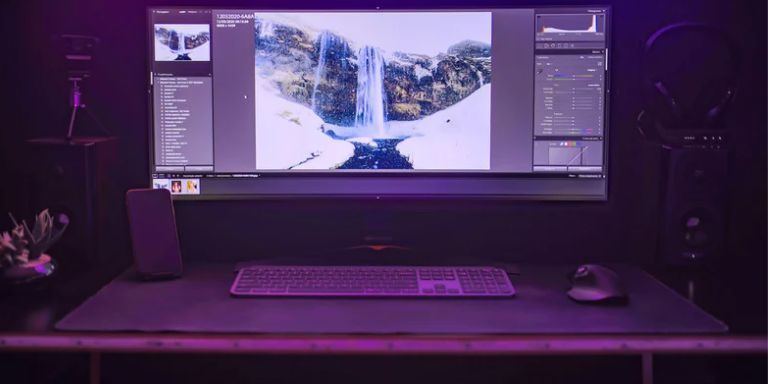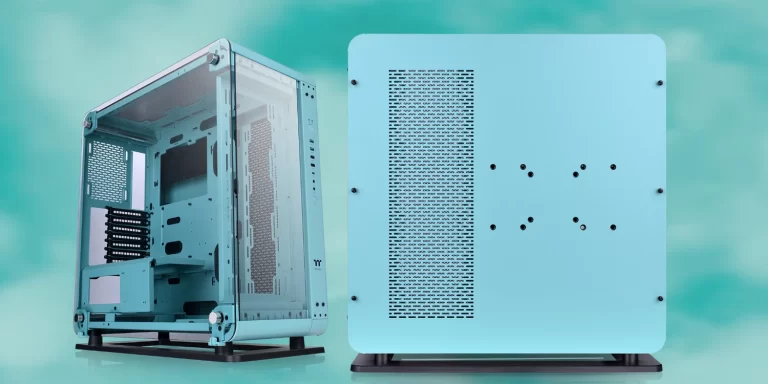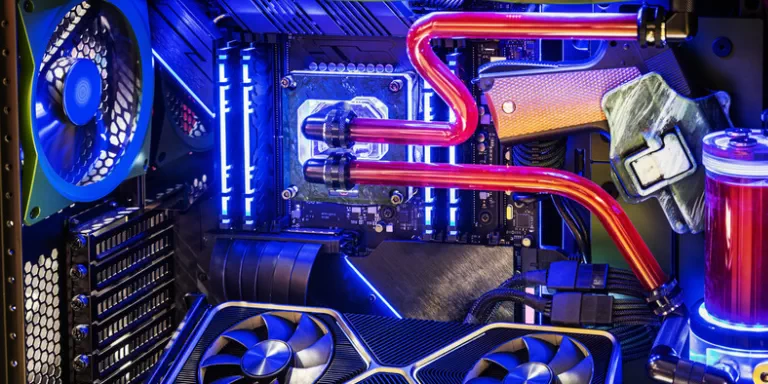
Setting up a high-performance PC is tricky business. You need to consider CPU and GPU speeds, RAM configuration, storage solutions, and more are required.
One of the important factors in achieving an optimal gaming experience is proper air circulation within your PC case. There’s nothing worse than trying to get that extra edge in a game only for your computer components to overheat and throttle performance due to poor ventilation.
There are, thankfully, a few simple steps you can take to ensure that PC case airflow is running at its best. In this post, we will discuss how to properly position fans and radiators for liquid cooling systems so that everything runs cool without making too much noise. Let’s jump right into it!
- Fundamentals of PC Case Airflow
- Air Direction: Fresh Air Intake and Hot Air Exhaust
- Positive or Negative Case Pressure?
- Push or Pull for the Radiator?
- Location of the Radiator?
Fundamentals of PC Case Airflow
CFM of a PC Case Fan
Cubic Feet Per Minute (CFM), is a metric that tells you how much air your PC case is capable of pushing through the enclosure.
The higher the CFM rating, the better the airflow. However, when the CFM is too high, you must also consider the noise and dust. PC case fans typically have adjustable airflow with a flow range of 35 to 60 CFM.
RPM and Noise
RPM (Rotations Per Minute) refers to the rate a fan rotates in your PC case, providing cooling and ventilation throughout. This speed directly affects the amount of cool air entering and hot air exiting your system, helping keep components such as the CPU and GPU running smoothly and efficiently.
Higher RPMs are associated with significantly lower temperatures, thanks to improved airflow through your case. However, keep in mind that faster speeds imply higher fan noise levels.
Ultimately, you want to strike an ideal balance between performance and silence by adjusting the fan speed or rate at which it rotates as with this Corsair Obsidian 1000D that comes with a built-in fan speed controller.
Fan Size
When it comes to airflow in PC cases, size does matter. Seriously, if you want your PC to be silent and efficient, then bigger fans are the way to go. Not only is a bigger fan more powerful than its smaller counterpart when it comes to generating the same amount of airflow, but it also requires less RPM so it operates quite quietly.
Sure, little fans have their uses, like tucking them away in those hard-to-reach corners of your PC case. But, if you want the best PC setup possible, select a PC case that allows you to mount large fans.
Fan Type
PC gaming enthusiasts have known that there are two kinds of fans available for the inside of a PC case: static pressure fans and airflow fans. Static pressure fans create a forceful air stream, perfect for when you’ve got lots of obstacles blocking air within your computer case.
Conversely, airflow fans are best for cases without obstruction to their path, because they provide a straight direction of influence. No matter which type fits you best, never underestimate the importance of cooling in a combination of high temperatures and highly sensitive components. It can be a game-changing factor.
Air Direction: Fresh Air Intake and Hot Air Exhaust
The basic airflow inside a PC case is critical to keeping it running smoothly. This is achieved by having a fresh air intake and hot air exhaust, allowing your computer to stay cool even when you’re pushing it hard.
Fresh air intake brings cool air into the case, which then flows over and around all your hardware components. Hot air is then extracted from the case by exhaust fans at the back or top of your cabinet, keeping temperatures low and preventing overheating.

PRINCIPLE OF AIR DIRECTION:
For optimal design, the air intake should be coming in from the front (sometimes side panel) or bottom of your case, with the hot air being expelled forcefully through the back or top.
Positive or Negative Case Pressure?
PC case pressure is important to consider when it comes to maintaining good airflow inside your PC.
Negative pressure happens when the amount of exhaust air from the PC case is greater than the amount of air intake. This implies that outside air can be passively sucked in, which might cause dirt to be drawn into your PC case. It is clear that the negative pressure model might lead to decreased cooling effectiveness because of dirt buildup and a shortage of fresh air intake.
Positive pressure, on the other hand, occurs when more air intake is compared to how much exhaust. This is generally better for keeping components cool when there is more fresh air coming in from the outside. Furthermore, because the pressure inside the case is greater than the surrounding atmosphere, some of the dust inside the case will be pushed out.
There has been a lot of doubt about what kind of pressure is better for PC builds. Actually, a computer case with a slight positive pressure is the ideal airflow situation. It helps in better cooling while effectively adding fresh air from the outside and limiting dust accumulation inside your rig. To achieve this pressure level, you’ll need to be mindful of your fan selection. Make sure that the total CFM of intake fans is slightly larger than what is being expelled from the case.
Push or Pull for the Radiator?
If you install a liquid cooling system, the air direction must therefore adhere to the above-mentioned principles. However, there will be three different ways to place fans on radiators, as follows:
1. Pull: The spinning of the fan will create a vacuum effect to draw air through the radiator.

2. Push: The fan will push air through the radiator to cool it.

3. Push & Pull: Arrange two fans, one pushes air and the other sucks air through the radiator. This configuration will reduce the fan speed making the system run quieter but the downside is that it will take up more space. Therefore, Push & Pull is rarely applied.

In general, Push or Pull configurations usually do not differ much in cooling performance. They will be applied depending on the installation location. For example, if the radiator is installed on the top, it will be a Push configuration, on the front will be a Pull configuration.
Location of the Radiator?
There is an interesting study posted on MSI about the effect of air bubbles in radiators on cooling performance. Accordingly, installing a radiator on the front (tubes down to avoid air bubbles) will give the best CPU cooling performance. If the radiator cannot be installed on the front, mounting it to the top is also a good option.

Final Thoughts
In conclusion, optimal PC case airflow is essential for keeping your components running smoothly and preventing overheating. To achieve this, make sure the air intake comes from the front or bottom of your case with hot air being expelled forcefully through the back or top.
Additionally, understanding how to create positive or negative pressure inside your PC cabinet can help you maintain good airflow while also filtering out dust particles. Lastly, when it comes to radiators be mindful of their location and proper fan setup: push, pull, or a combination of both depending on where they’re installed in your system.
With these suggestions, you’ll have a better chance of improving your system’s cooling capabilities while making sure all other components are properly cooled as well.









